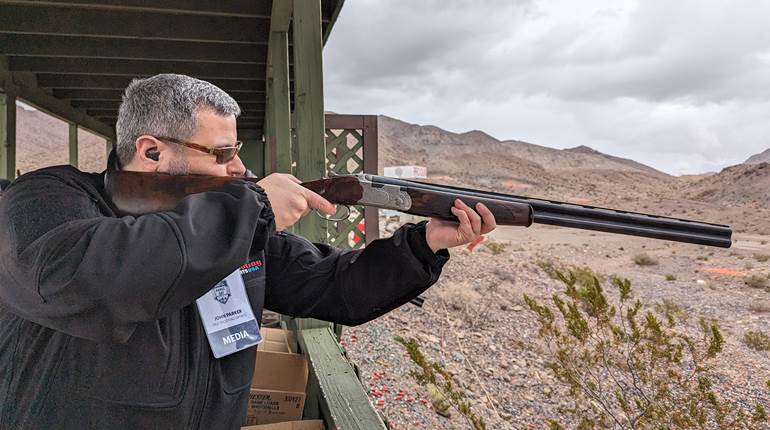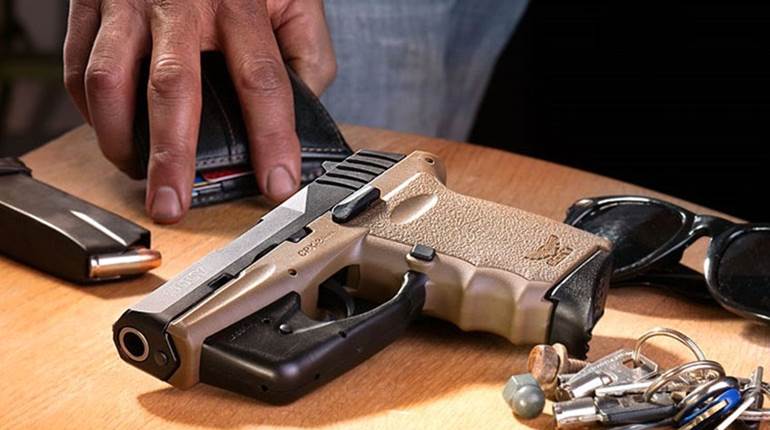
Since its unveiling in 2001, the Turkish-made Model 2000 has served as Stoeger’s flagship semi-automatic shotgun, and for good reason. When teamed with modern, high-performance shotshells, the 3-inch-chambered, 12 gauge handles nearly all tasks without costing the proverbial “arm and leg.” For a marketplace increasingly dominated by more-versatile 3½-inch-chambered shotguns, Stoeger recently introduced its 3½-inch-chambered Model 3500.
Like the M2000, the M3500 uses what the company calls the “Inertia Driven System” of operation, but the M3500 has a fixed cam pin in the bolt body and helical cam on the bolt head, while the others, the M2000 included, have a cam groove cut into the bolt body and the cam pin runs through the bolt body.
Upon firing, the gun, steel locking head included, moves rearward; however, due to its mass the steel bolt body temporarily remains in place. As the locking head travels rearward, the stiff “inertia” spring is compressed, which delays opening of the bolt head until pressure has dropped.
During firing, the M3500’s hammer spring also moves the cartridge lever upward, which disengages it from the carrier latch. This enables a shotshell to transition from the magazine tube onto the carrier. By pressing against the rear of the carrier latch, the shell rotates it counterclockwise, preventing another shell from exiting the magazine tube.
As the bolt body travels rearward, the locking head pin, in conjunction with the angled cut on the locking head, forces the head to rotate, unlocking it, extracting—via a claw-type extractor—the spent shell (hull) from the chamber and pulling it against the spring-loaded ejector. As the bolt assembly moves rearward the hull is ejected, the hammer is re-cocked, and the action bar spring, located on the magazine tube, is compressed, which forces the bolt assembly forward. This lifts the awaiting shell into position and chambers it, at which time the locking head rotates to lock up the action. Once the hammer spring is compressed the cartridge drop lever moves downward.
Since the system requires no gas to function, the action, fore-end and barrel (exterior) remain cleaner, thus contributing to enhanced reliability and quicker clean-up. In fact, even after shooting about 100 rounds of assorted 12-gauge shotshells of various brands, lengths and types during testing, a quick wipe down with a silicone-impregnated cloth was all that was necessary to clean and preserve the M3500. Regardless of length (from 2¾ to 31/2 inches), when using shotshells meeting the 2¾ inch, 11⁄8-ounce, 3-dram-equivalent minimum, the Stoeger functioned without issue. Even with light, 2¾-dram loads, the M3500 exhibited only a few hiccups.
Because it’s a non-stressed component, the M3500’s receiver is made of aluminum alloy to save weight. The bolt head locks into the steel barrel extension. The barrel, which is available in Realtree APG and Max-4 HD camouflage patterns as well as matte black to match the receiver, buttstock and fore-end, features a stepped, ventilated rib and front sight with a large fiber-optic strand. Interestingly, the receiver is drilled and tapped for the included Weaver-style base, though the included screws with the test gun were of insufficient length to install the base. Stoeger informed us this has not been reported with other production M3500s. The barrel accepts choke tubes and comes with five.
The synthetic buttstock and fore-end both feature molded-in checkering to enhance purchase, and the buttstock has a molded-in sling swivel stud. The second is located on the magazine tube cap. Capping the buttstock is a 3/4-inch-thick ventilated rubber recoil pad. Given its 3½-inch chambering, Stoeger thought it prudent to help attenuate recoil. Its cost-conscious solution is a 10.2-ounce cylindrical steel weight that screws directly onto the stock screw. The gun also comes with shims to adjust drop and cast.
The M3500’s fire controls mimic those of the M2000, featuring a standard crossbolt-style safety and a cartridge drop lever. The test gun’s trigger broke at 8 pounds, 10 ounces and exhibited considerable creep.
To evaluate the M3500, in this case a 28-inch-barreled Realtree Max-4 HD version, we subjected it to function- and field-testing, as well as patterning.
The addition of the weight certainly reduced recoil with 3 and 3½-inch loads; however, after a box or so of magnum-type loads it worked loose, requiring removal of the recoil pad for retightening. This occurred several times during testing.
From the bench, using sandbags for support, we patterned the M3500 at 40 yards. A modified choke tube, combined with Winchester’s new 3-inch Blind Side 13⁄8-ounce steel loads, led to fairly consistent patterns, and more importantly, consistent sighting, though we found the fiber-optic strand a bit large.
As for field-testing, a staffer used the initial prototype in the spring of 2008 to take a Rio Grande gobbler while hunting at Sarco Creek Lodge in Texas. Although its release was delayed until this year, the same American Rifleman editor used the test gun to kill a Virginia tom. In both cases the M3500—with the supplied Extra Full choke tube—performed admirably, delivering the tight patterns to cleanly take the birds.
Priced at $627 (matte black) or $679 (camouflage), the Stoeger Model 3500 could easily be the best buy for hunters demanding a 3½-inch-chambered 12-ga. semi-automatic shotgun. It’s stylish, simple to maintain, reliable and has only those features important to the diehard hunter.
Importer: Stoeger Industries; (301) 283-6300; www.stoegerindustries.com
Gauge: 12, 3½" chamber
Action Type: inertia recoil-operated, semi-automatic shotgun
Receiver: machined aluminum alloy
Barrel: 24" (Realtree APG only), 26", 28"
Choke: interchangeable, screw-in choke tubes: extra full, full, modified, improved cylinder, cylinder
Magazine: tubular; four-round capacity
Trigger: 8-lb., 10-oz. pull
Stock: synthetic: length of pull, 143⁄8"; drop at heel, 2½"; drop at comb, 1½"
Overall Length: 46" (24" barrel) to 50" (28" barrel)
Weight: 7.45 lbs. (24" barrel) to 7.65 lbs. (28" barrel)
Accessories: choke tube wrench, five chokes, magazine plug
Suggested Retail Price: $629 (matte black), $679 camouflage






































